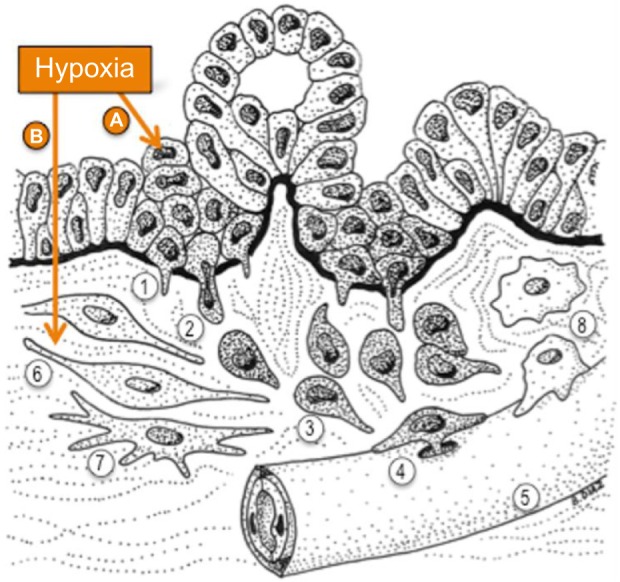Figure 3.

Hypoxia potentiates invasive steps in PDAC.
Notes: Hypoxia in the tumor microenvironment potentiates PDAC cell invasiveness by inducing molecular pathways that affect (A) the cancer cells and (B) the tumor stroma. (A) Hypoxia promotes EMT and also facilitates the invasive migration of cancer cells through extracellular barriers. Upon EMT, epithelial cells lose the attachment to their neighboring cells within the epithelial layer and acquire a migratory phenotype. The process of invasion starts when PDAC cells breach the epithelial basement membrane that separates the epithelium from the stroma (black). Invasion is aided in vitro and possibly in vivo by the formation of proteolytic protrusions named invadopodia (1) that locally digest the basement membrane, generating pores that cancer cells use to cross it and reach the stroma (2). Once in the stroma, PDAC cells display invasive directed migration, aided by EMT and the proteolytic activity of invadopodia (3) toward blood (5) or lymphatic vessels to intravasate and disseminate through the circulation. PDAC cells are likely to use invadopodia to cross endothelial basement membranes (4) and reach the circulation. (B) Hypoxia affects the tumor stroma by promoting the profibrotic activity of cancer-associated fibroblasts (6) and pancreatic stellate cells (7), which further increases hypoxia in the tumor microenvironment, and also by promoting the crosstalk between cancer and stromal cells to increase cancer cells invasiveness (see text for details). Hypoxia may also affect the recruitment and activation of macrophages (8), which also interact with cancer cells to facilitate invasion, for instance, during intravasation. Hypoxia is a determinant of PDAC invasiveness through the activation of cell autonomous and non-cell-autonomous mechanisms that operate in both cancer and associated stroma.
Abbreviations: EMT, epithelial-to-mesenchymal transition; PDAC, pancreatic ductal adenocarcinoma.
